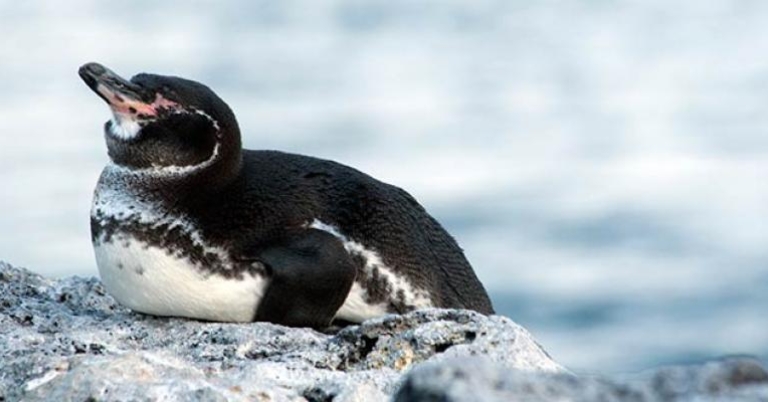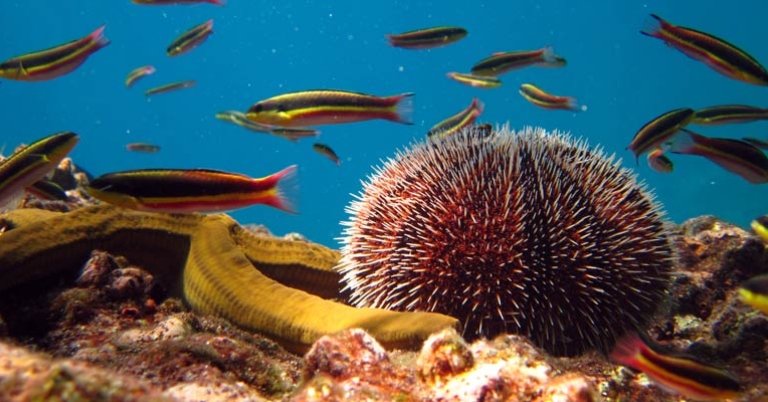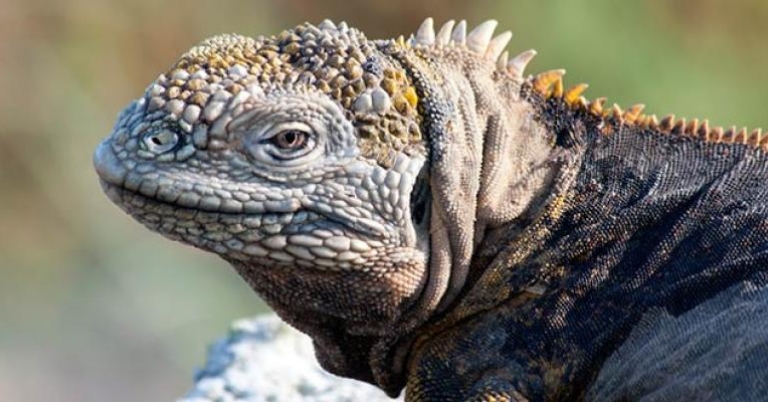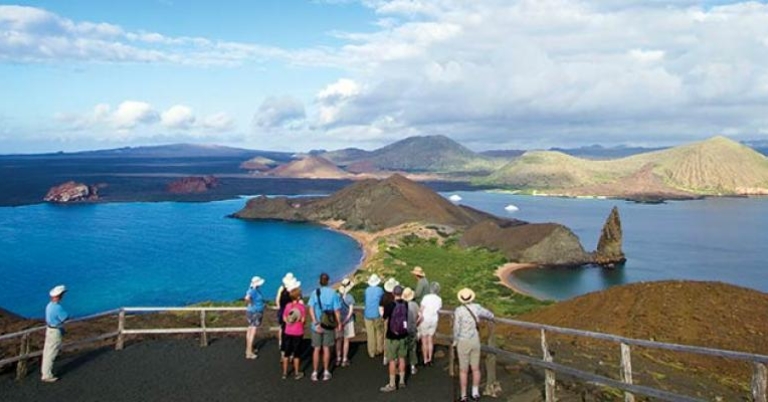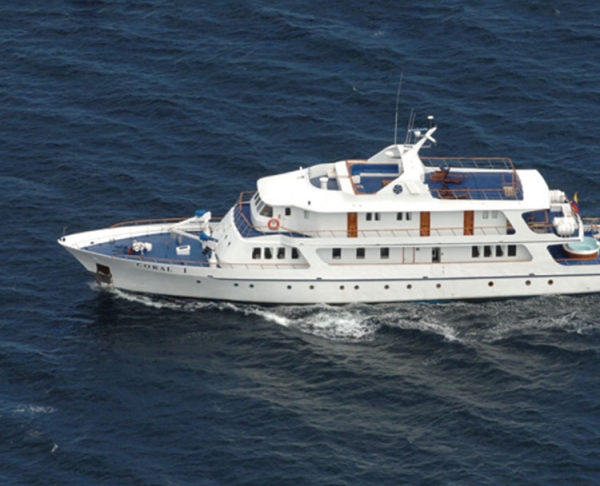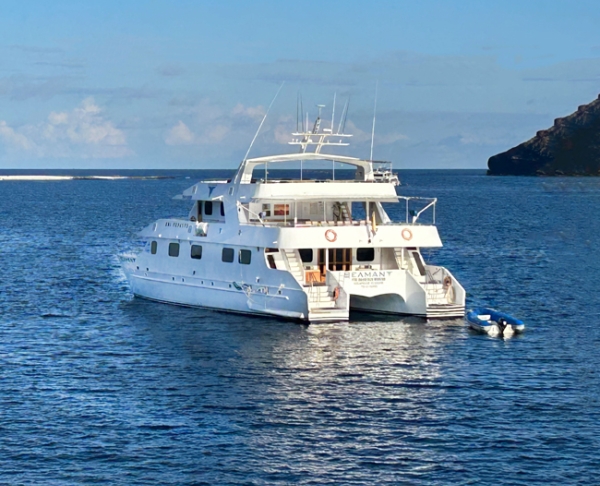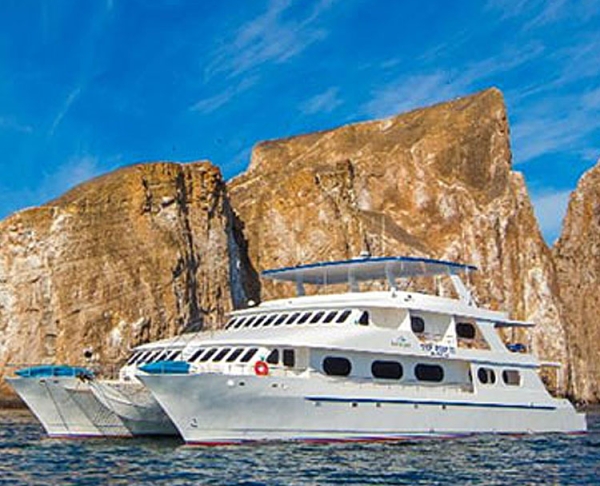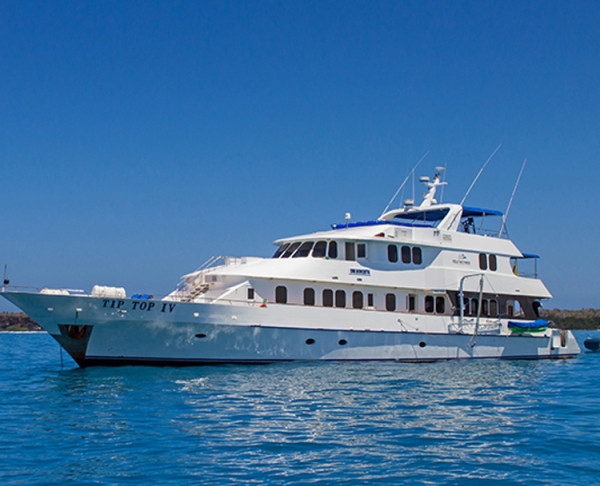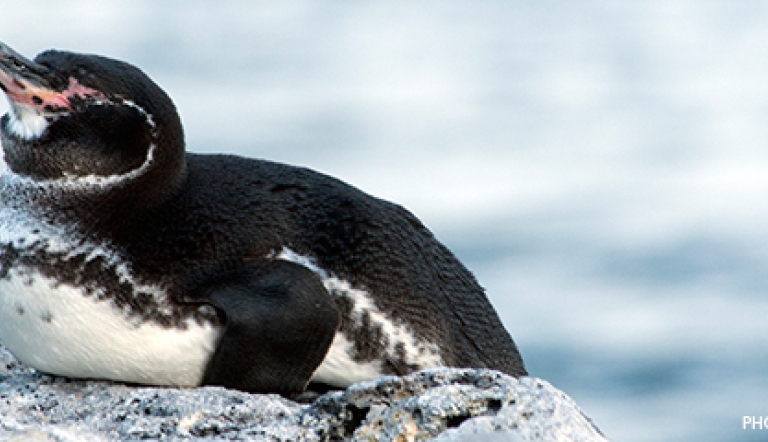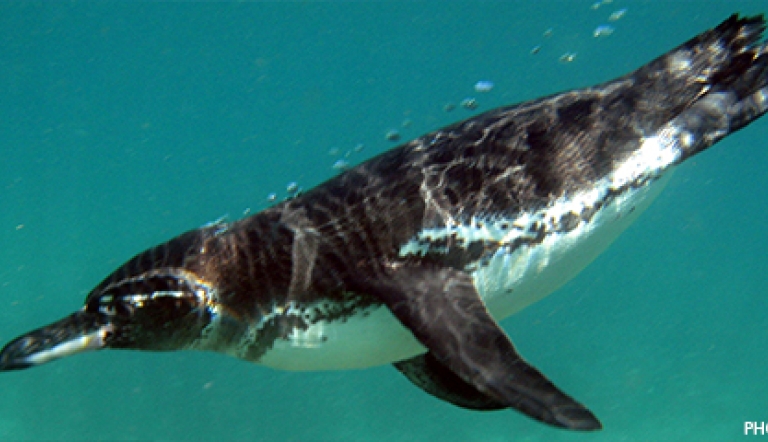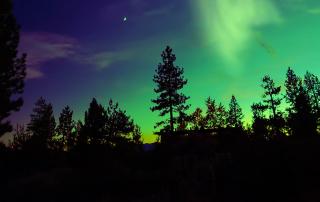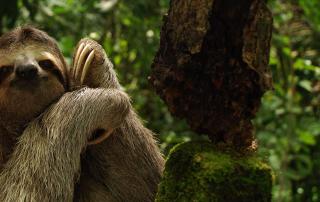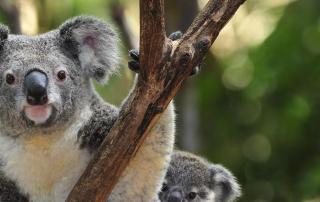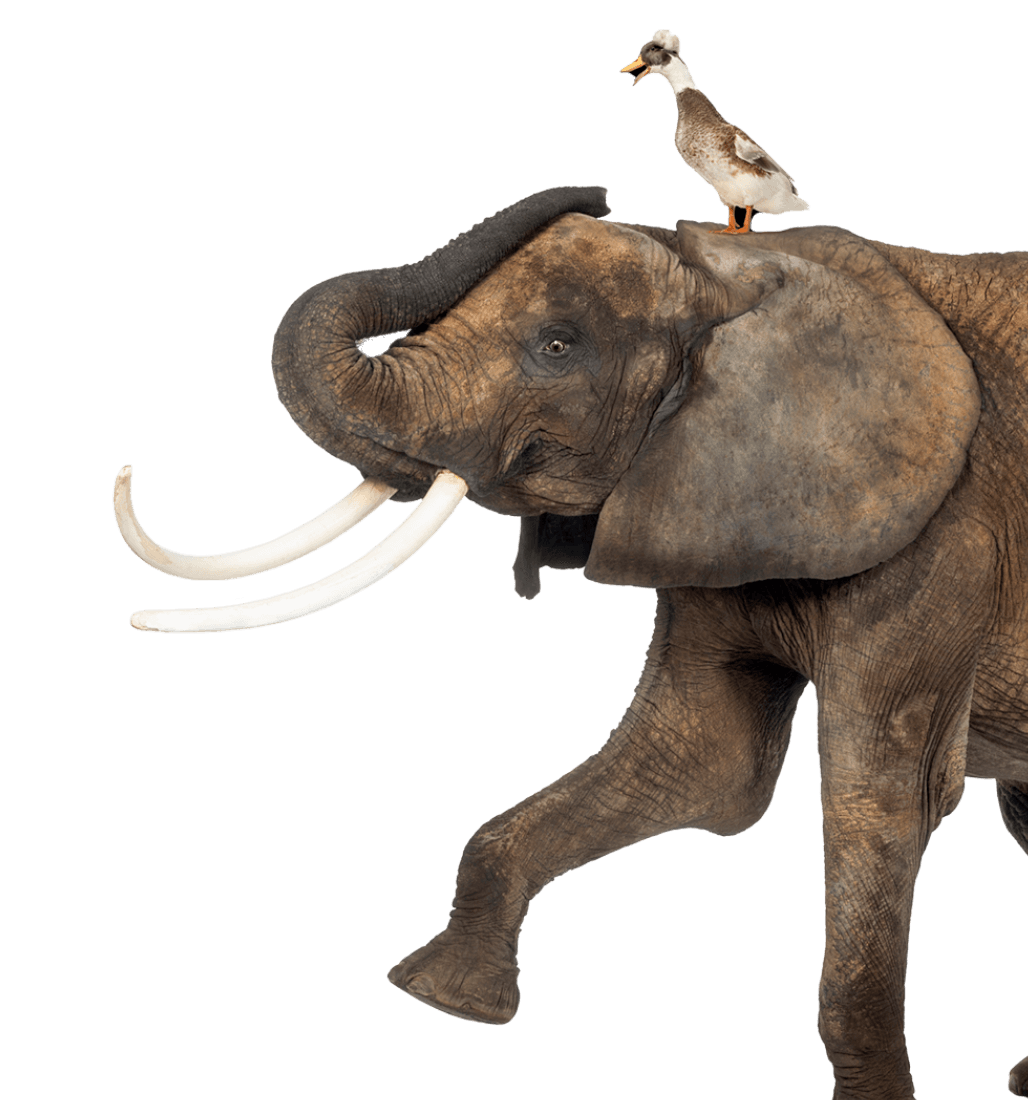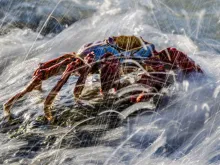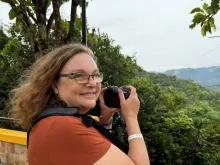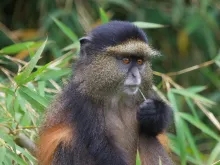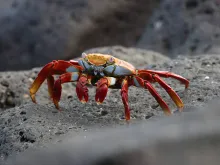What he saw on an isolated group of islands out in the Pacific began an intellectual voyage that would span 20 years and would culminate in the then revolutionary theory that living things are shaped by the world around them. Darwin found a place where some birds no longer fly, tortoises weigh 500 pounds, penguins live on the equator, and Blue-footed Boobies perform elaborate dances for their mates.
As Darwin found, a main reason for the uniqueness is their remoteness. Officially part of the Archipielago de Colon, the islands straddle the equator 600 miles off Ecuador’s coast. Thirteen major islands, dozens of small lava islets, and reefs dot about 3,000 square miles of the Pacific. To populate the barren islands, seeds, insects, birds, and animals traveled on driftwood and strong winds. Because no humans landed before the 16th century, flora and fauna flourished untroubled and adapted to the new environment’s demands.
Explorers discovered the islands in 1535 and during the next 300 years Spanish mariners, British buccaneers, renegades, and pirates visited them periodically in search of shelter. Today, the human population is confined to the four larger islands and is engaged in farming, fishing, raising cattle, and tourism. The Charles Darwin Research Station, housed on Santa Cruz Island, trains naturalist guides from all over the world and is charged with the task of advancing conservation on the islands.
Flora and Fauna
The Galapagos Islands are known the world over as a top destination for studying endemism, biodiversity, and natural history. Due to their isolation, the archipelago’s plants and animals have adapted to their unique environments, often varying even from island to island, and a lack of predators has resulted in wildlife that is curious and unafraid. A variety of habitats—from mangroves, lagoons, and sandy beaches to cactus forests, lush highlands, and grassy pampas—bring visitors face to face with iconic wildlife: Blue-footed Boobies, land and marine iguanas, Darwin’s finches, Galapagos Penguins, Flightless Cormorants, and giant Galapagos tortoises, among others. Below the ocean surface, divers and snorkelers swim alongside sea lions, white-tipped reef sharks, manta rays, sea turtles, and colorful tropical fish.
Conservation
The balanced ecosystem of the islands can be damaged easily by disturbance or by the introduction of exotic plants and animals. In the Galapagos, humans have introduced more than 150 plants, from roses to balsa trees. Likewise, introduced animals have seriously impacted native species of plants and animals. The Charles Darwin Foundation inaugurated interest in Galapagos conservation in 1959, and all of the islands were declared a national park. In 1964, the Darwin Research Station on Santa Cruz opened. The islands provide multiple opportunities to learn about conservation: Visitors can see rare and endangered tortoises at the Tortoise Breeding Center on Isabela Island, discuss management techniques with pioneering local conservationists, and assist with habitat restoration or other hands-on projects, all for a deeper understanding of the ongoing measures to preserve the islands’ precious resources.
TIP NOTE: You'll be walking up to 3 hours per day over uneven trails in hot and humid condition.
Geology
The Galapagos Islands, located on a tectonic plate and formed as the product of a mantle plume, are part of a highly active geological region, characterized by numerous volcanoes (six of which are still active), fumaroles, cinder cones, and other formations. Pinnacle Rock, the remnant of a tuff cone, is one of the most famous sites in the archipelago; Sierra Negra is one of the largest calderas in the world; and the twin pit craters known as “Los Gemelos” offer a fantastic view. For an up-close look at geological processes in action, Galapagos is the perfect classroom.
Entry & Exit Requirements
U.S. and Canadian citizens must have a valid passport to enter Ecuador. Passports must be valid for at least six months after the date of departure.
A visa is not required for visits up to 90 days.
The Galápagos National Park Administration also requires travelers to complete an electronic affidavit with their travel information and a declaration of transported goods.
This affidavit may be completed up to 48 hours prior to arrival in the Galápagos. As most travelers will already be in Ecuador or en route to Ecuador during this timeframe, your guide will be able to assist you with this process. It will be helpful for you to have a smartphone or other mobile device to complete the affidavit, but if you don’t have one, your guide can help make arrangements for you to access the internet before your flight. Should you be arriving to Ecuador with more time available, you may complete the form within 48 hours of your flight at https://declaracion.abgalapagos.gob.ec.
If you are not traveling with a U.S. passport, please check with the Embassy of Ecuador for the requirements based on your nationality.
Health Information
IMMUNIZATIONS
The Centers for Disease Control recommends that all travelers be up to date on routine vaccinations such as measles-mumps-rubella (MMR) vaccine, diphtheria-pertussis-tetanus vaccine, varicella (chicken pox) vaccine, and your yearly flu shot before every trip.
There are no vaccinations required for entry into Ecuador.
Some physicians recommend that travelers get hepatitis A and typhoid vaccines before visiting Ecuador.
Yellow fever is a risk in certain parts of Ecuador. The CDC recommends the yellow fever vaccine if you are traveling to these areas.
Please consult your physician for additional information and recommendations based on your individual circumstances.
MALARIA
Though the CDC estimates that the risk of malaria for U.S. travelers in Ecuador is low, they still warn that all travelers to South America could potentially be exposed to malaria. Malaria is caused by a parasite found in Anopheles mosquitos, which are active from dusk until dawn. Prevention is twofold: the use of anti-malarial drugs and the prevention of insect bites. If you choose to use an anti-malarial drug, as recommended by the CDC, see your physician for a prescription.
CHIKUNGUNYA
In December 2013, French Guiana reported locally transmitted cases of chikungunya for the first time in South America. Local transmission means that mosquitoes in the area have been infected with chikungunya and are spreading it to people. CDC recommends that travelers to the South America area protect themselves from mosquito bites.
SEA SICKNESS
If you’re prone to feeling queasy we suggest you consult your physician for advice on the best ways to prevent motion sickness. We recommend that you avoid showering when the boat is in motion and remain cautious of activities while passing through rocky waters.
ALTITUDE SICKNESS
Upon arrival at locations of high elevation, shortness of breath and a pounding heart are normal responses to the lack of oxygen in the air. However, for some visitors, these symptoms can deteriorate into altitude sickness. Headache, extreme tiredness, dizziness, nausea, and loss of appetite are standard symptoms. Staying hydrated and well rested is important to adjust to the altitude. Avoiding heavy, fatty foods and alcohol in the days before arriving to altitude can help. Over-the-counter medications are also available to help prevent or alleviate symptoms. It’s advisable to avoid sleep medications, as they can slow breathing and respiration, which aid in getting the blood oxygenated while sleeping. Participants who take blood pressure medications should discuss this with their doctor as the medication can drop pressure too low at times.
SUN EXPOSURE
The effects of the sun can be damaging to the eyes and skin. Spending time outdoors exposes you to the sun’s harmful ultraviolet (UV) rays, even on cloudy days. To protect yourself from the sun, use a broad spectrum sunscreen of at least SPF 15, protect skin with clothing, wear a wide-brimmed hat and sunglasses, and drink plenty of fluids.
PHYSICAL FITNESS REQUIREMENTS
Visitors to the Galápagos Islands should be in good health and capable of walking over rocky, uneven, and potentially slippery terrain. Regardless of your physical stamina, bringing a walking stick will help maintain your balance. For more information, please view the following video, which outlines fitness requirements more thoroughly.
Currency
The currency of Ecuador is the U.S. Dollar.
Electricity
The electrical current in Ecuador is 120V 50Hz AC. Travelers from the United States do not need to use a converter.
Time Zone
The time zone of mainland Ecuador is Ecuador Time Zone (UTC-05:00). The Galapagos Islands are on Central Standard Time, although some yachts choose to remain on Eastern Standard Time to simplify matters.
Ecuador does not observe Daylight Saving Time.
Departures and arrivals on flight schedules are listed in the local time.
Communications
PHONES
Ecuador’s country code is +593.
To call Ecuador (from the U.S.): Dial 011-593-(xx-xxx-xxxx)
To call the United States: Dial 001-(xxx-xxx-xxxx)
Cell phone coverage is available but not perfect. There are service towers near the towns. Please check with your cell phone provider if you’re unsure whether or not your cell phone will work internationally. Be aware that you are likely to incur additional charges for international use.
INTERNET
Internet is widely available in Ecuador and many lodges offer WiFi. Internet is not likely to be available on board your boat, but there are Internet cafes in Puerto Ayora, Puerto Villamil, and San Cristobal.
Reading List
Field guides
Galapagos Wildlife, A Visitor's Guide
David Horwell & Pete Oxford
With chapters on visitor sites, history, conservation and habitats, this compact photographic guide introduces birds, reptiles, marine and other life of the archipelago.
Wildlife of the Galapagos
Julian Fitter, Daniel Fitter & David Hosking
A compact identification guide to Galapagos nature and wildlife, featuring 400 color photographs, an overview of the history, climate, evolution and geology of the islands, and helpful full-color visitor site maps.
Galapagos Islands Marine Life
Idaz Greenberg
This double-sided plastic card shows the most commonly encountered reef fish of the Galapagos in full-color illustrations. Waterproof, it's convenient for the boat or beach. Size: 6 x 10 inches.
Galapagos Wildlife
Pocket Naturalist
A fold-up, laminated card featuring color drawings and short descriptions of commonly encountered birds, mammals and reptiles of the Galapagos.
Galapagos Wildlife
Celter Visual Arts Inc.
Spot, identify and appreciate the wildlife of the Galapagos with this laminated, submersible accordion-style fold-out guide. Vivid images of birds, fishes, invertebrates, reptiles and mammals are paired with English and Spanish names, approximate size and a handy check box to keep track of your findings.
Birds, Mammals and Reptiles of the Galapagos Islands
Andy Swash & Robert Stills
This strikingly compact, comprehensive field guide features 500 color photographs, distribution maps and information on status, habitat and behavior.
Flowering Plants of the Galapagos
Conley McMullen & Ghillean Prance
Indispensable for the botanically minded, this excellent guide features color photographs of 436 species, an overview of ecology and habitats and plant checklists for visitor sites.
Galapagos Birds Life
Celter Visual Arts Inc.
Spot, identify and appreciate the avian life of the Galapagos with this laminated, submersible accordian-style fold-out guide. Vivid images of a wide variety of birds common are paired with English and Spanish names, approximate size and a handy check box to keep track of your findings.
Galapagos Marine Life
Celter Visual Arts Inc.
Spot, identify and appreciate the marine life of the Galapagos with this laminated, submersible accordian-style fold-out guide. Vivid images of a wide variety of fish are paired with English and Spanish names, approximate size and a handy check box to keep track of your findings.
MAPS
Galapagos Islands Explorer Map
Ocean Explorer Maps
Not just handy for keeping track of your Galapagos cruise, this detailed map (1:400,000) of the islands includes illustrated biographies of famous visitors and a wildlife guide.
Ecuador Adventure Map
National Geographic Society
This double-sided, waterproof map covers Ecuador in splendid detail (1:750:00) and also includes a Galapagos map (1:1 million).
GUIDEBOOKS
Insight Guide Ecuador and Galapagos
Insight Guides
Presenting the natural history, politics, culture, wildlife and attractions of Ecuador and the Galapagos Islands with style and authority.
Moon Galapagos Islands
Ben Westwood
Based in Ecuador, Westwood writes with insight in this brief guide to the pleasures and practicalities of visiting Galapagos.
NATURAL HISTORY
Galapagos, A Natural History
Michael H. Jackson
This comprehensive guide to the natural history of the Galapagos is practically mandatory reading -- the single best introduction to the geology and climate, habitats, plants, birds, animals, ecology and evolution.
Galápagos: A Natural History (Second Edition)
John C. Kricher and Kevin Loughlin
This illustrated natural history offers comprehensive and detailed accounts, with more than 650 color photographs of the islands’ habitats, marine life, reptiles, birds, mammals, and plants.
The Beak of the Finch
Jonathan Weiner
This Pulitzer Prize-winning work is an accessible look at the modern debate on the mode and rhythm of evolution, using the story of Peter and Rosemary Grant and their ground-breaking field work on Daphne Major as an example.
The Galapagos, A Natural History
Henry Nicholls
Editor of the Galapagos Conservation Trust magazine and author of Lonesome George, Henry Nicholls charts the human and natural history of the archipelago from its fiery origins through famous visitors and current conservation challenges.
Galapagos, Exploring Darwin's Tapestry
John Hess
Professor Hess pulls off the rare trick of being both scientifically accurate and inviting in this illustrated coffee-table primer on Galapagos, its geology, evolution and magnificent wildlife.
Galapagos, Islands Born of Fire
Tui De Roy
A stunning celebration of the landscapes, wildlife and habitats of the Galapagos by a photographer who was raised in the archipelago. Tenth anniversary edition.
Galapagos, The Islands That Changed the World
Paul D. Stewart
Stewart and co-authors, associated with the BBC natural history unit, present the natural and human history of the islands in this wide-ranging, beautifully illustrated book, the companion to the BBC series.
Lonesome George, The Life and Loves of the World's Most Famous Tortoise
Henry Nicholls
The lone tortoise from Isla Pinta, corralled at the Charles Darwin Station since 1971 until his death in 2012, stands at the center of Nicholl's witty, affectionate tale of conservation, biology and hope.
Evolution's Workshop
Edward J. Larson
A vivid history of the Galapagos and the role of the islands as a crucible of evolutionary ideas, written by a Pulitzer Prize winner. Larson covers Darwin and the discovery of the islands, the visits of Hancock and Beebe, the influence of the United States during WWII and the establishment of the national park.
HISTORY & CULTURE
Voyage of the Beagle
Charles Darwin
The wide-eyed tale of a young man on a five-year voyage that changed his life -- and our way of thinking about the world. First published in 1839, it's still a marvelous introduction to the wildlife, nature and allure of South America.
The History of Ecuador
George Lauderbaugh
this compact book includes chapters on Ecuador today, Ecuador's indigenous and colonial past, the oil boom and other events.
Satan Came to Eden
Dore Strauch
The original memoir of Dore Strauch, early settler to the Galapagos and participant in the fascinating unsolved mystery known as The Galapagos Affair, the subject of a new documentary. First published in 1936, it's back in print after 80 years.
Galapagos: The Enchanted Islands, Through Writer's Eyes
John Hickman
Hickman weaves original accounts by Galapagos whalers, gentleman pirates, fitful castaways, settlers and scientists, including Ambrose Crowley, Herman Melville, Charles Darwin and William Beebe, in these tales of the colorful human history of the archipelago.
Galapagos, World's End
William Beebe
This wry, wonderfully evocative account of a 1924 scientific expedition includes an excellent chapter on the human history of the Galapagos.
Galapagos Boats
We have choices suitable for every budget, and all of the boats that we work with meet high-level safety standards that are carefully monitored by our staff. Our naturalist guides will provide expert interpretation and enhance the journey.
Cruising with Holbrook means that we've done the legwork, and with more than 40 years under our belt, your trip will be smooth sailing!
Galapagos Safety the Holbrook Way
- Mandatory on-board safety drill
- Strict adherence to local certification requirements
- Ongoing marine safety inspections
- Snorkeling safety standards



